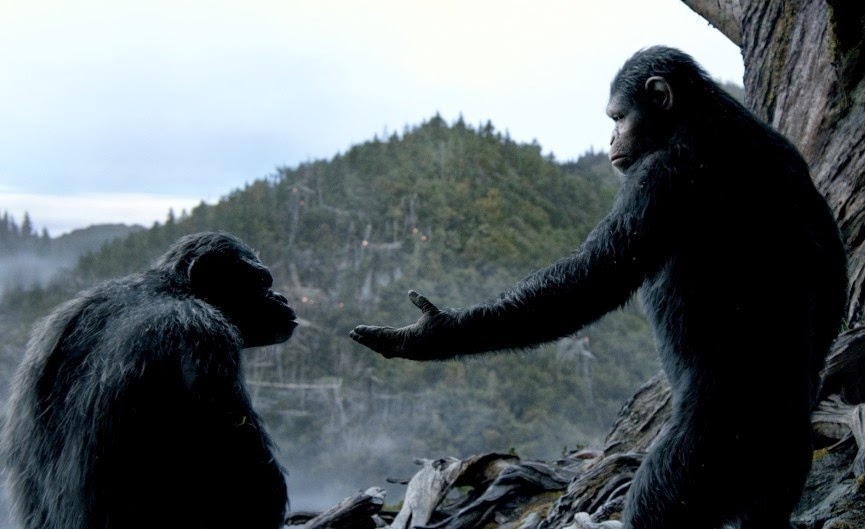Monkeyshines: 4 notes on Dawn of the Planet of the Apes
1) Perhaps I shouldn't have watched the visual effects featurette beforehand, because I couldn't help seeing the strain in Dawn of the Planet of the Apes' motion-capture acting, the convenient plotting that maintains conflict, and the self-congratulatory blockbuster-worthy earnestness of it all. In the featurette, the director Matt Reeves talks about his attempts to get to the emotions of his audience. Perhaps consequently, I was unfavorably struck by the movie's many manipulative tender scenes. We see the leader of the apes Caesar (Andy Serkis) gazing off into the rainy redwood forest outside of San Francisco, maudlin family scenes with Caesar's sickly wife and computer-generated baby chimpanzee cooing like a simian variation of the little CGI monster baby of The Twilight Saga: Breaking Dawn Part 2, sympathetic human Malcolm (Jason Clarke) touching foreheads with Caesar in a cross-species moment of trust, father-son bonding between Caesar and his sensitive older son Blue Eyes, and, lastly, Caesar's many gestures of leadership, such as when he stands up straight and says things like "Apes don't want war but will fight if we must" and "Ape home. Do not come back" and "Ape not kill ape" and "I will decide by morning" as he looks proudly to the left with the weight of the apes' fate on his noble shoulders.
2) I guess I just like my movies to be more subversive, with more trickster figures, but Matt Reeves keeps a tight focus on a small colony of earnest humans in San Francisco after "ten winters" and a Contagion-like flu has wiped out 99% of the humans from the earth. Naturally, the small colony have many guns on hand to enhance later scenes. In the nearby woods, the apes like to decorate with large logs scattered around in pick-up-sticks fashion. Naturally, they live practically on top of a hydroelectric dam that could bring power to the poor Franciscans who just want to use it to communicate with someone else by radio, if anyone else exists on earth. Of course, there are no other energy sources around. I did like the grunge look of post-apocalyptic humans, with many characters wearing jeans, construction boots, and long sleeve henley t-shirts. The city overtaken by wildlife looks cool, and the apes move well en masse, swarming over the Golden Gate bridge as if the movie's director was raised on Vertigo.
3) I kept looking for Gary Oldman (who plays colony leader Dreyfus) to apologize for his Playboy interview during his speeches to his fellow humans.
4) Caesar's Scar-like sidekick Koba (Toby Kebell) does have playful moments in the midst of spying on the humans' massive arsenal. To defuse tension with 2 armed men that he encounters, Koba romps around, rolls over, lounges back on a seat, steals their bottle of liquor, tries to drink, and then splatters them with alcohol. He fools them into complacency before taking a gun and spraying them with machine gun fire. Koba's monkeyshines bring the film to life, but the few lighter scenes emphasize the programmatic nature of everything else--every bomb, tower, climactic fight, and plot twist betraying the blockbuster conventions peeking through the scenic ruins. I could picture noble Caesar sitting on his horse, straightening his back, and saying "Caesar tired of all this posturing. Apes need to set up sequel. Humans eager to repeat mistakes of 'civilization' by seeing more movies of this ilk."
2) I guess I just like my movies to be more subversive, with more trickster figures, but Matt Reeves keeps a tight focus on a small colony of earnest humans in San Francisco after "ten winters" and a Contagion-like flu has wiped out 99% of the humans from the earth. Naturally, the small colony have many guns on hand to enhance later scenes. In the nearby woods, the apes like to decorate with large logs scattered around in pick-up-sticks fashion. Naturally, they live practically on top of a hydroelectric dam that could bring power to the poor Franciscans who just want to use it to communicate with someone else by radio, if anyone else exists on earth. Of course, there are no other energy sources around. I did like the grunge look of post-apocalyptic humans, with many characters wearing jeans, construction boots, and long sleeve henley t-shirts. The city overtaken by wildlife looks cool, and the apes move well en masse, swarming over the Golden Gate bridge as if the movie's director was raised on Vertigo.
3) I kept looking for Gary Oldman (who plays colony leader Dreyfus) to apologize for his Playboy interview during his speeches to his fellow humans.
4) Caesar's Scar-like sidekick Koba (Toby Kebell) does have playful moments in the midst of spying on the humans' massive arsenal. To defuse tension with 2 armed men that he encounters, Koba romps around, rolls over, lounges back on a seat, steals their bottle of liquor, tries to drink, and then splatters them with alcohol. He fools them into complacency before taking a gun and spraying them with machine gun fire. Koba's monkeyshines bring the film to life, but the few lighter scenes emphasize the programmatic nature of everything else--every bomb, tower, climactic fight, and plot twist betraying the blockbuster conventions peeking through the scenic ruins. I could picture noble Caesar sitting on his horse, straightening his back, and saying "Caesar tired of all this posturing. Apes need to set up sequel. Humans eager to repeat mistakes of 'civilization' by seeing more movies of this ilk."



Comments